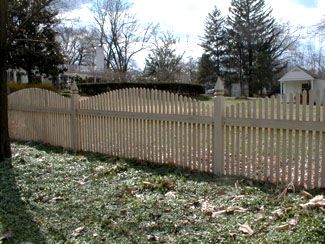Lasting Materials for Wood Fences

Lasting Materials for Wood Fences | Here is my wood fence. It is a combination of treated lumber and rough-sawn cedar. We painted it to match our house and the paint job still looks good even after 14 years!
Wood Fences That Last
DEAR TIM: What is the best wood, both economical and durable, for a fence? The fence will be subjected to both hot and cold weather, if that factors into your opinion. If I decide to use CCA treated lumber, can I paint it or should it just weather? What is the best way to set the posts? Should they be surrounded with concrete or gravel? Dan H., Omaha, NE
DEAR DAN: If after reading this you decide to use chromated copper arsenate (CCA) lumber, you need to do the job this year. The CCA lumber industry and the EPA reached an agreement last year that calls for CCA lumber to be removed from the consumer market on December 31, 2003. There are other chemically treated lumbers available that will take the place of CCA lumber if you happen to be a procrastinator.
Wood fences create a delightful look and feel. I think the thing I like most about wood is that you often have an infinite number of possibilities with respect to design and texture. But there are two things that can restrict what your fence will ultimately look like: your own imagination and any local zoning laws, that limit the type of fence you can install. Be aware that some zoning laws can be highly restrictive to where fences can be used, their height, and even the type of material to be used. Some sub-divisions may have deed restrictions that further prohibit the fence size and type. Be sure to investigate all of these things before you make a trip to the lumber yard.
Can you get sick from CCA lumber?
Chemically treated lumber is an industry currently in transition. The removal of CCA lumber from the consumer market has gotten the attention of many consumers who are afraid of chemicals. There are countless stories and claims about people who have become very sick from exposure to CCA lumber. If these are true and factual, would you want your children climbing on such a fence? Is it worth the risk? Those are tough questions to answer. In your case, it may be a moot point. Two coats of exterior paint that contain both acrylic and urethane resins might encapsulate any chemicals in the wood for a very long period of time.
What natural woods are best for fences?
You have other wood options. Mother Nature has been manufacturing naturally rot and weather-resistant lumber for many years. Ask any farmer about the longevity of locust fence posts. Redwood and cedar also make superb long-lasting fencing materials. Both of these wood species have grades that are very affordable. Do not be fooled by the prices of clear redwood and cedar. You do not need this premium grade for fencing. Choose a more economical grade such as construction heart redwood or similar grade of cedar. If you are lucky, try to see if you can round up some bald cypress. This lumber species weathers outdoors very well.
Thirteen years ago, I built my own decorative wood fence. It was a combination of wood materials. I used CCA treated lumber for the posts and horizontal frame members. Since my wife wanted the fence to be painted as you do, I built the frame in the fall and let it weather until the next summer. This gave the lumber plenty of time to expel any excess moisture. The pickets of the fence were made from rough-sawn cedar.
The painting of my fence happened in stages. I painted the posts and horizontal frame members completely before I installed the vertical pickets. Each individual picket was completely precut to size and painted on all sides and edges before they were installed. I paid close attention to the bottom end of each picket. This spot received three coats of paint since it would be so close to the ground. Be sure to use stainless steel nails or hot dipped galvanized nails to fasten the fence parts together.
I did not use concrete or gravel to set my posts. Fortunately, I owned a post hole digger that created a hole just two inches in diameter larger than the size of my posts. After digging the holes two feet deep, I used a scrap 4x4 piece of lumber to compact the earth at the bottom of each hole. I then set each post in line and made sure it was plumb as I carefully tamped earth around all four sides of the post. My fence has remained in perfect position for the past thirteen years. If a post does go bad for some reason, the absence of concrete or gravel will make it a quick and easy job. Before you begin to dig any fence post holes, make sure there are no underground utility lines in the vicinity of the fence line.
I received an email asking in part... "I am going to buy a nailer to rebuild my wood fence. What diameter nail would I use for this project? Can the nailer be used for different size nails on other projects?"
Use a ring shanked 8 or 10 penny nail. You can use different length nails of the same diameter if they are made specifically for that gun.
Column 458